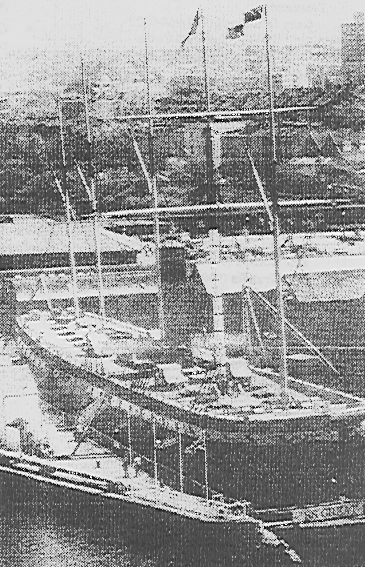 |
FAMOUS SHIPS |
 |
FAMOUS SHIPS |
THE "GREAT BRITAIN "
This is a departure from the normal in that this ship was primarily a steam ship with sail power used only for auxiliary purposes. However, she did at one point in her life become a pure sailing ship and was successful for a period of time. I am talking about the first true steam - screw propelled ship ever built the GREAT BRITAIN. She was at first to be a sister ship to THE GREAT WESTERN, which was the first successful steam-driven transatlantic passenger liner. Isambard Brunel, one of history's greatest and most colorful engineers designed both ships.
While being built in the late 1830's iron plates became available and were utilized to construct her hull. In addition, improved screw propulsion was developed and Brunel decided to incorporate this feature into this ship as well. Thus, she was launched THE GREAT BRITAIN, a 3,500 ton, 322 foot long, fully powered screw steamer with a very sophisticated six-masted schooner rig for "sail assist." At this time she was the largest ship ever to be built and had that distinction for many years. She was the first modern ship incorporating in her design many entirely new features that resulted in standard ship building practice to this day. The beautiful shape of her hull anticipated the American clippers of the 1840's.
Her history spanned many years. She began by being put into service as a passenger liner on the New York run. She was just beginning to earn her pay on this run when she was run ashore on the Irish coast due to gross navigational error. She was sold by her original owners, The Great Western Steamship Company, refitted, and put into the passenger trade to Australia. Here she paid off very well, making 32 round-trip voyages along with 3 voyages to New York and troopship duties during the Crimean War in 1855 and the Indian Mutiny in 1857. She was a highly successful ship, both profitable and very popular with her passengers.
 In
1876, THE GREAT BRITAIN could no longer compete with more modern compound-engine
vessels, and she was changed into a pure sailing ship, her engines being removed
from her hull. She was in trade between South Wales and San Francisco with coal
out and wheat home, rounding Cape Horn twice on each voyage. On the third voyage
she became damaged by storms off the Horn and put into the Falkland Islands.
Here her upper masts were sent down and she became a floating storehouse for
wool and coal. She laid in this capacity until 1937, when she was abandoned,
partly sunk.
In
1876, THE GREAT BRITAIN could no longer compete with more modern compound-engine
vessels, and she was changed into a pure sailing ship, her engines being removed
from her hull. She was in trade between South Wales and San Francisco with coal
out and wheat home, rounding Cape Horn twice on each voyage. On the third voyage
she became damaged by storms off the Horn and put into the Falkland Islands.
Here her upper masts were sent down and she became a floating storehouse for
wool and coal. She laid in this capacity until 1937, when she was abandoned,
partly sunk.
Her she lay until 1967, when Dr. Ewan Corlett started an effort to save her, indicating that this ship was "one of the very few really historic ships still in existence." As a result of his initial efforts, a group was formed that determined that the ship's hull was in a condition to be saved. The group, overcoming many obstacles, organized her return to Britain - even to the very dock at which she had originally been built in Bristol.
Today, THE GREAT BRITIAN is restored, as far as her external appearance is concerned, to be exactly as she was at her launch in 1844. She is an astonishing survivor from the early days of the modern world, a monument to the entrepreneurial daring and technological innovation of the greatest days of the Industrial Revolution. She can today be seen at her dock in Bristol, England.
This was the most exciting experience in CROMDALE's career. Her best passage was made in 1894, when she arrived off Prawle Point on April I 0'1', 80 days out of Sydney. In 1898 Captain Sibley took over the command. Her last commander, Captain Authur, of Dundee, took over command in 1913. On her return voyage she was wreaked off the Lizard in a very dense fog.